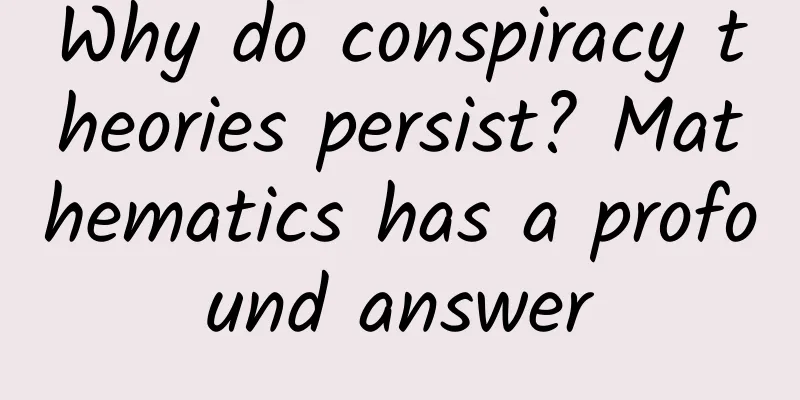Why do conspiracy theories persist? Mathematics has a profound answer

|
Many conspiracy theories start like this: as long as the database is large enough, eyes eager to find patterns will always find something that looks suspicious. But in fact, humans are particularly bad at identifying what is truly random. However, if you understand mathematics, you can realize that some counterintuitive results are actually completely predictable and not weird at all. By Eddie Woo Translated by Yang Xiyi In the early 1970s, the Watergate scandal engulfed American politics and forever changed the way people viewed the presidency. President Richard Nixon was found to have committed serious crimes and to have arranged a huge cover-up. Why did this incident have such a profound impact on the public psyche? Part of the reason is that the public saw the events unfold in such a dramatic way. When the Watergate scandal first broke, most people thought it was just a minor incident that would soon fade from the news, just like any other incident on a normal day. As the investigation progressed, people realized that this matter would not end soon, and the mainstream view was that Watergate was becoming a far-fetched witch hunt. Few people could tolerate the fact that the head of state was a criminal who was willing to participate in treasonous activities and abused his privileges to trample on justice. For a while, the minority who believed that President Nixon was guilty were regarded as weirdos and conspiracy theorists whose ridiculous stories were not feasible and could not be true. Until the plot twists and turns, and everyone's worst fears suddenly come true. After a series of twists and turns worthy of a Hollywood blockbuster, the shocking truth finally comes to light - and the conspiracy theorists were right all along. Watergate was a turning point in the age of conspiracy theories. Before then, people who believed in code words, secret societies and government cover-ups were often seen as crazy. But Watergate forced the public to acknowledge that even the most outrageous claims could sometimes be true. Mathematics has an answer to why conspiracy theories thrive and re-emerge in every corner of the world. Surprisingly, it shows us that conspiracy theorists never run out of raw materials for their mill. We swim in a natural ocean of data, and the nature of our world means that conspiracy theorists can always point to something and say it’s “evidence” of suspicious behavior and secrets under our noses. To understand how this all happens, let's think about a very simple puzzle game that children play. You've no doubt heard of it: word search. I spent a lot of time playing this game. I even had a book of word search puzzles growing up (which, I now realize, was one of my mom’s go-to tools for quieting down when she was getting too annoyed with me). The word search puzzle looks like this: This puzzle contains all seven colors of the rainbow: red, orange, yellow, blue, green, indigo, and violet. Some words need to be found horizontally, others need to be read vertically, and there are even words hidden on diagonal lines. Be careful - some words are written backwards (right to left, not left to right). As an extra bonus, there's another color hidden in this chart that I didn't mention - see if you can find it! It's not hard to create your own word search puzzle. I just drew a blank sheet and added the words I wanted to add one by one. Once I did that, I just had to fill in the blanks with a series of random letters. Boom! The word search puzzle appeared. But what if I skip the first step — adding my words to the puzzle? What happens if I create a puzzle made up entirely of random letters? Here’s an example of a 3×3 table: As expected, it looks like a complete mess. And it is — no matter how you look at it, you can’t find any English words in this table. But now, let’s see what happens if I add a row and a column: If you start at B in the first row and follow the diagonal line down and to the right - obviously, you'll see the word "bad" pop up! Not only that - start at the second letter in the second row and read from left to right, you'll find the second word: dad. Is this bunch of random letters trying to say, I'm not a good dad?! If I add another row and column to make it a 5×5 table, you’ll see even more words appearing naturally. In addition to “bad” and “dad,” I see “in,” “do,” “no,” “zed,” “be,” “bade,” and “ado.” The number of words skyrockets! What’s going on here? I didn’t deliberately write down any words in this table – the following two tables were randomly created in the same way, and each table is filled with the same words: In the table on the left, I can find: pony, ox, log, not, hue, yay, and spa. The table on the right contains: elf, ox (it appears three times!), ex, cam, do, red, fun, gap, oh, lo, and no. You can create your own "random" word search table by typing this URL into your search engine: www.bit.ly/findaword. If you go to this URL and play around, you'll also see that it's really hard to create a table that doesn't contain any English words. So, what's going on? What you observed is called the impossibility of disorder. There must be islands of order in the sea of chaos - as long as the sea is big enough. We have just proved this statement ourselves: there are no words in the 3×3 table, but as the table gets larger, it becomes very difficult to avoid words. The branch of mathematics that studies this is called Ramsey theory, named after the British mathematician and economist Frank P. Ramsey. Few of you may have come across this aspect of mathematics because it belongs to a field called graph theory, which is not covered in all compulsory mathematics courses in Australia. If mathematics taught in school is like a trip to Sydney, then algebra is the opera house - everyone goes to see it eventually. On the other hand, graph theory is like your local convenience store - it is not a popular place for tourists, and only a small number of people know about it. Like the convenience store, these people know about it because it can help them solve daily problems. The clearest example of Ramsey's theory is a scenario called the "Party Problem." Anyone who has ever hosted a party knows that deciding on a guest list is a difficult task. Sure, everyone you invite is your friend, but are they friends with each other? Graph theory is the mathematics of relationships, and it helps us understand any situation where things are connected to each other through special relationships. For example, rail lines connect suburbs, and electric wires connect houses - friendships bring people together. For example, let's say you want at least three people at your party who are either friends or strangers. In either case, you can guarantee they'll have something to talk about. If all three know each other, they'll hit it off like a house on fire. If all three are new to each other, they can get to know each other at your party. Everyone's guaranteed to have a good time! The first way graph theory helps us understand and solve this problem is that it provides us with a way to describe this situation in mathematical form. Some questions in life are difficult to answer because it is difficult to even clarify the situation. However, if we can extract the key details with a simple diagram, the problem is half solved. The two circles below represent two people at the party. If there is a solid line between them, it means they know each other, and a dotted line means they don't know each other. With this tool, we can diagram the "party" of any relationship, whether they know each other or not. If we invite 5 people to the party in addition to A, there are 12 basic combinations of the relationship between this particular guest (in this case, A) and the other guests. In all 12 cases, you can see that a small group of three people is highlighted - they are either friends with each other or they don't know each other. Since we can always find three people who know each other or who don't know each other, this means that as long as you invite at least 6 people, you will definitely find such a small group. If you want to know how the diagram on the left page was drawn and how we proved that 6 is the minimum number to ensure this situation, please jump directly to the chapter "6 people are enough". What does this have to do with our word search puzzles or conspiracy theorists? Well, Ramsey Theory tells us that as a combinatorial structure - be it a group of friends, a word search table, or even a newspaper article - expands, certain structures and "patterns" will inevitably emerge. So when our table expands to a certain size, English words will appear out of thin air. Furthermore, this is how many conspiracy theories begin. As long as the database is large enough, eyes eager to find patterns will always find something that looks suspicious. Numerologists, who look for patterns in numbers and are adept at ascribing significance to specific numbers, had a field day in 2017 when musician Jay-Z released an album titled 4:44, which also featured a song of the same name. The singer-songwriter apparently woke up at that time and wrote the song. One numerologist suggests that the song's title has a lot to do with Jay-Z's personal life: "[His wife's] birthday is the 4th, his mom's birthday is the 4th, his birthday is the 4th, and he got married on the 4th." It's certainly an amazing pattern, but the Ramsey Theory clearly tells us that in a world with 7 billion people, such coincidences are bound to happen somewhere. (After all, there are 12 4ths in a year - which means that at least 230 million people alive today were born on the 4th, and a lot of them are married to each other!) Ramsey's theory states that structure will inevitably and spontaneously emerge from chaos (if it's large enough!), and sometimes it will appear in our daily lives in the most unexpected ways. For example, Apple encountered unexpected spontaneous structure when it released the iPod. Although portable music players had been around for many years before that, the introduction of the iPod led to a huge increase in the number of people who could access their entire music library wherever they went. CD players could only hold one album at a time, but the iPod broke that limitation and allowed people to easily carry hundreds or even thousands of songs in their pockets. The iPod shuffle had this new feature, too, except it featured random playback. This model of iPod was designed to randomly select songs from its built-in music library, and it did so—but users around the world began reporting strange behavior. "My iPod is acting up—I have dozens of artists in my library, but it'll occasionally play four or five songs from the same band!" They thought their player was broken, and it no longer "randomly" played as advertised. Some even came up with a theory: They thought their device seemed to have its own personality, with a preference for certain artists. "I never hear Madonna in my library... my iPod seems to be obsessed with the Foo Fighters!" Ramsey's theory taught us that this is a completely predictable outcome. If you listen to hundreds of hours of random music, sooner or later you'll hear several songs by the same artist in a row. The longer you listen, the more likely this will happen—just as the larger the word search table, the more likely it is that meaningful words will spontaneously appear. Ironically, the reason we always find patterns in randomness is largely because humans are actually very bad at identifying what is truly random. For example, look at the results of coin tossing (heads or tails) in the following table: Compare it with the following table: Spoiler alert: One of these two charts isn't actually the result of a coin flip—it was created by a person pretending to flip a coin. Can you tell the difference? Math tells us the answer: Because coin tosses are so easy to understand in terms of possibility and probability, we can predict with great accuracy the probability of different sequences of results (such as heads followed by tails, or three tails in a row). The truth is that the first table records the results of real coin tosses, and the second table is fake. The second table rarely shows the same result multiple times in a row, which betrays its human fabrication. Humans think that four heads or tails in a row is abnormal - but if you toss the coin enough times (as shown in the first table), it will happen. British fortune teller and magician Derren Brown took advantage of this phenomenon in a performance when he flipped 10 heads in front of live cameras. In this age of CGI, most people thought he must have tampered with the film. But Brown was not spoofing, either in terms of the angle or the editing - he really flipped 10 heads in a row. However, to get this footage, they spent more than nine hours filming to finally get 10 heads in a row! It may sound extreme, but such a long shooting time almost guarantees 10 heads in a row. If you flip a coin 2,025 times in a row, you will even find that the most heads in a row is not 10, but 15! This mathematical phenomenon has more serious applications. When it comes to probability, humans intuitively believe that the probability of anything happening in a row is low. In a casino, this intuition can be disastrous if it is wrong. Compulsive gamblers often report that they have an uncontrollable belief that after so many consecutive losses, they will eventually win. This gambler's fallacy is both incorrect and tragic—people who believe it often lose money because their intuition is so wrong. The consequences of this aspect of Ramsey's theory intersecting with human physiology are more subtle. Take, for example, the famous placebo effect: Even if the drug or treatment you take doesn't biologically help your condition, it may still improve your health. This has been documented so well that when people do clinical trials of new drugs, they require a placebo group in addition to the experimental and control groups. The control group doesn't take the drug, the experimental group takes the new drug to be tested, and the placebo group takes a sugar pill with no active ingredient - they just think they are taking the real drug. Invariably, someone in the placebo group reported that the new drug made them feel better, even if they hadn’t actually taken it. For some of them, the improvement was partly because they believed they had taken the drug. How could the human body actually improve because of a drug that didn’t exist? This is the law at work. Modern people have been exposed to the connection between medicine and health since childhood. In psychological terms, this is called classical conditioning. Conditioning can trigger real biological reactions. The most memorable example of this comes from Russian physiologist Ivan Pavlov. In that famous experiment, Pavlov gave food to dogs only after ringing a bell. After establishing this law, the dogs participating in the experiment would salivate in anticipation of a meal just by ringing the bell - even without food. From a statistical point of view, we can say that Pavlov input data into the dog group, suggesting that there is a certain connection between food and the bell. Now let's combine this idea with Ramsey's theory. Suppose you start selling sugar pills that have no medical effect, but you label them as cold medicine. People buy them when they are sick because they think this is an interesting new product worth trying. According to Ramsey's theory, we can predict that if enough people buy and take the sugar pills, then there will definitely be a random group of people who will feel less sick or get better faster than usual while taking the pills. These consumers may then inadvertently associate their improvement with taking the medicine, even if they are taking a placebo sugar pill that has no effect! If you master the right observation method, you will find islands of order everywhere in the sea of chaos. The sky is a perfect stage, which well demonstrates that as long as there is enough data, all kinds of unusual patterns will inevitably emerge. During the day, you will see that the white clouds in the sky are so similar to fish. The night sky proves this point even more powerfully: for millions of years, the starry sky has provided people with so many opportunities that the various constellations that people have imagined have a wide variety of interesting shapes and stories. About the Author Eddie Woo Born into a Chinese family, he is a famous mathematics teacher in Australia, the chief mathematics teacher of the largest public high school in Sydney, and the father of three children. In 2012, Wu lost his class due to cancer, so he made interesting videos of his class and uploaded them to YouTube for the student to watch at home. Unexpectedly, these videos quickly became very popular among students, and Wu became known and loved by students and mathematics enthusiasts around the world. To date, Wu has 1.4 million YouTube fans and his videos have been viewed more than 100 million times. In 2018, Wu was named one of the top ten teachers in the world by the Global Teacher Award. In the same year, he was awarded the "Local Hero of the Year Award" by New South Wales, Australia for his outstanding contribution to education, and attended the Australia Day celebrations to deliver a speech, becoming the first Chinese guest in Australian history to speak at the National Day celebrations. This article is authorized by the publisher and is selected from "Teacher Wu's Fun Mathematics Class" (Tianjin Science and Technology Press, May 2022) Special Tips 1. Go to the "Featured Column" at the bottom of the menu of the "Fanpu" WeChat public account to read a series of popular science articles on different topics. 2. Fanpu provides a function to search articles by month. Follow the official account and reply with the four-digit year + month, such as "1903", to get the article index for March 2019, and so on. Copyright statement: Personal forwarding is welcome. Any form of media or organization is not allowed to reprint or excerpt without authorization. For reprint authorization, please contact the backstage of the "Fanpu" WeChat public account. |
<<: Can't eat anything if you have diabetes? Beware of malnutrition!
>>: Is it possible for a person to eat only one thing?
Recommend
The World Archaeology Forum awarded him the "Lifetime Achievement Award". He is the first Chinese archaeologist to receive this award!
Recently, another major event happened in the wor...
The tableware you use every day, using it incorrectly is equivalent to chronic "poisoning"! Be careful of these 7 types of materials →
Tableware is something we come into contact with ...
How to use the "expert" economy, which is more lethal than "Internet celebrities", to market products
Jiuzhilan Interview: A one-stop strategy for buil...
Lenovo brand Sharp manufacturing - Lenovo Smart TV S9 "Terminator" is in good condition
Lenovo smart TV is here with the attitude of a &q...
What are the functions of merchant mini program development?
1. Promotion function: After opening the mini pro...
Ehang on the edge of the cliff: Layoffs are just a superficial phenomenon, the company is entering the countdown
Down with Sad As a winner of Toutiao's Qingyu...
Bao Juncheng: [ATA Full Literacy] Collection of Folk Songs from All Directions Series
Bao Juncheng: [ATA Full Literacy] Introduction to...
How to develop a complete user growth system architecture?
If you learn the right principles in the field of...
Why are fruits becoming sweeter and sweeter? Is this unhealthy?
Have you noticed that fruits are getting sweeter ...
Photo browsing artifact source code sharing
Source code introduction: Share a beautiful pictu...
Didi, Bilibili, Xiaohongshu... Reviewing the growth path of 10 phenomenal products
Product Life Cycle Before reviewing the product, ...
Those weird bugs
We can't say that all bugs are paper tigers, ...
How to plan an awesome online event!
How to plan a marketing campaign that is economic...
How to collect UGC content through event promotion operations?
1. How to increase the quantity and conversion ra...









